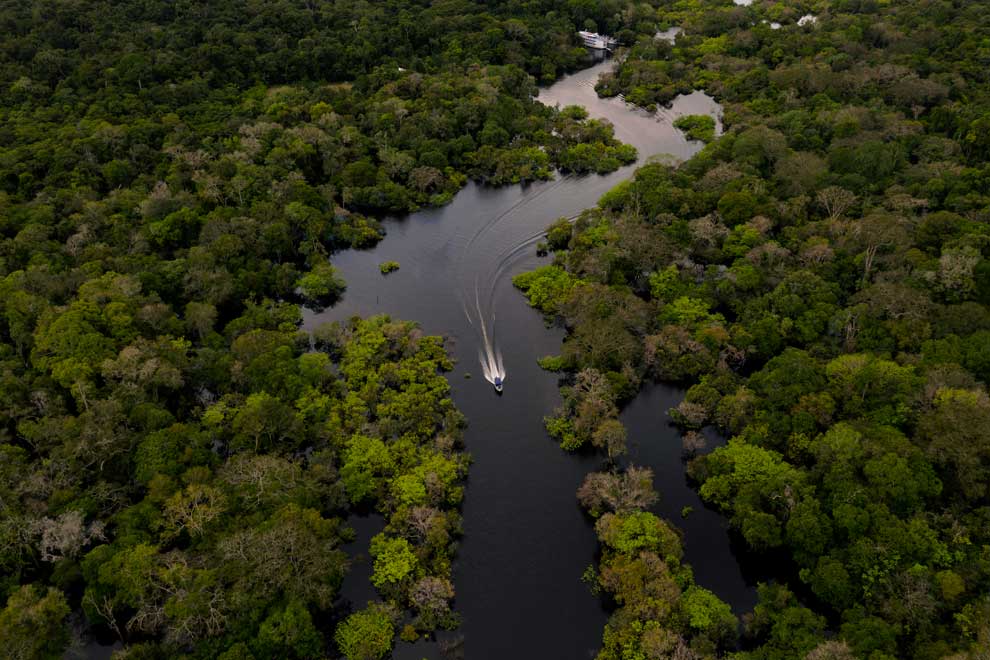
Aerial view showing a boat speeding on the Jurura river in the municipality of Carauari, in the heart of the Brazilian Amazon Forest, on March 15 last year. AFP
After decades of focus from the world’s governments, media and think tanks, most people now understand what climate change is and the impacts it implies to the future of humanity. Far fewer understand that the danger posed by biodiversity decline is every bit as serious.
The health of the ecosystems upon which mankind and the world’s species depend is deteriorating more rapidly than ever, threatening our health, food security, economic livelihoods and quality of life globally. Yet, biodiversity decline remains too far down on the list of priorities of most governments, businesses and people.
The impact of a typhoon or drought are evident for those impacted to see and feel, but we tend to take biodiversity decline for granted. Many of the costs of biodiversity decline remain hidden, which is part of the reason why so little is being done on a collective, sustained basis to combat it. As species gradually decline, too few of us notice.
Yet, according to the 2019 Intergovernmental Science-Policy Platform on Biodiversity and Ecosystem Services, 85 per cent of the wetlands present in 1700 had disappeared as of last year, 75 per cent of terrestrial environments (and 66 per cent of marine environments) have been severely altered, and a third of reef forming corals and marine mammals are now threatened with extinction. The alarm bells are ringing, loudly.
The world’s governments and businesses need to start taking this problem more seriously. Biodiversity decline needs to become a more mainstream economic and political issue. The Paulson Institute and Nature Conservancy have estimated that there is more than an $800 billion annual funding gap between what governments spend on biodiversity conservation versus the amount of protection required to turn the tide.
That kind of spending gap is too large to simply be legislated into existence. Governments have already proven they are not up to the task on their own; just 0.01 per cent of global gross domestic product is currently spent on biodiversity conservation.
Nature must itself be turned into an asset class. Businesses should come to realise that it is very much in their own interest to spend substantially more on biodiversity protection. They already know that being green can be profitable, as well as the right thing to do. The same can become true of biodiversity preservation. As any economy that is dependent upon tourism or any community dependent on self-sustaining agriculture already knows, a healthy ecosystem with vigorous biodiversity can make all the difference between economic livelihood and financial ruin.
The private sector has much to do – from supporting sustainable supply chains and reducing harmful subsidies (in areas such as agriculture, fisheries and forestry) to investing in biodiversity offsets, ramping up green investment and doing much more in the area of risk management solutions. Financial institutions can take a leading role by disclosing the biodiversity impacts of their investments and more seriously assessing how their investment decisions impact biodiversity.
The insurance industry has a unique role to play here, having already started to take notice and act in a meaningful way. For example, insurance underwriters have developed products that consider the role of coastal ecosystems in disaster management. In 2019, Mexico’s Coastal Zone Management Trust worked with a group of insurers to create an insurance product that pays to restore coral reefs immediately following strong hurricanes along the Yucatan Peninsula so that they will regenerate rather than die, saving reefs and helping to restore tourism-dependent local economies.
Since political risk insurance addresses action or inaction on the part of governments, underwriters could also begin to provide insurance against the failure of governments to act in a responsible manner regarding biodiversity when it impacts the ability of investments to successfully operate. There are many other potential ways in which insurance can make a real difference.
Similarly, the multilateral and bilateral development institutions have increasingly focused on the importance of biodiversity for sustainable socio-economic development at the policy and operational level. Along with the private sector, they have already proven capable of devoting resources to address biodiversity issues.
Public private partnerships also hold promise in this regard. However, all of these actors will need to take an increasingly active role in offering solutions, mobilisation of financial resources and provision of expertise to address the challenge of biodiversity decline. We still have time to reverse the harmful impacts of biodiversity decline, if we are smart enough to create sufficiently robust solutions and devote the necessary resources to get the job done. Given the rate of biodiversity decline, we don’t have much time left if we want our grandchildren to recognise the world we grew up in.
Daniel Wagner is senior investment officer for guarantees and syndications at the Asian Infrastructure Investment Bank in Beijing
THE JAKARTA POST/ASIA NEWS NETWORK







